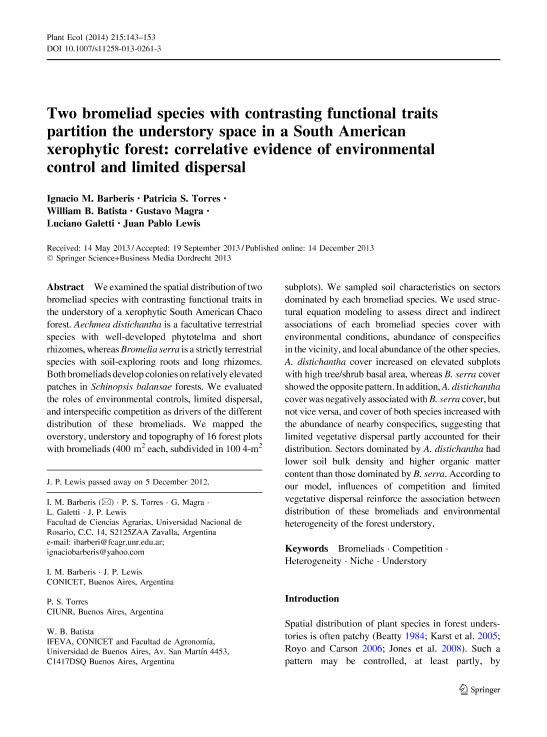Artículo
Two bromeliad species with contrasting functional traits partition the understory space in a South American xerophytic forest: correlative evidence of environmental control and limited dispersal
Barberis, Ignacio Martín ; Torres, Patricia S.; Batista, William B.; Magra, Gustavo; Galetti, Luciano Alberto; Lewis, Juan Pablo
; Torres, Patricia S.; Batista, William B.; Magra, Gustavo; Galetti, Luciano Alberto; Lewis, Juan Pablo
 ; Torres, Patricia S.; Batista, William B.; Magra, Gustavo; Galetti, Luciano Alberto; Lewis, Juan Pablo
; Torres, Patricia S.; Batista, William B.; Magra, Gustavo; Galetti, Luciano Alberto; Lewis, Juan Pablo
Fecha de publicación:
02/2014
Editorial:
Springer
Revista:
Plant Ecology
ISSN:
1385-0237
Idioma:
Inglés
Tipo de recurso:
Artículo publicado
Clasificación temática:
Resumen
We examined the spatial distribution of two bromeliad species with contrasting functional traits in the understory of a xerophytic South American Chaco forest. Aechmea distichantha is a facultative terrestrial species with well-developed phytotelma and short rhizomes, whereas Bromelia serra is a strictly terrestrial species with soil-exploring roots and long rhizomes. Both bromeliads develop colonies on relatively elevated patches in Schinopsis balansae forests. We evaluated the roles of environmental controls, limited dispersal, and interspecific competition as drivers of the different distribution of these bromeliads. We mapped the overstory, understory and topography of 16 forest plots with bromeliads (400 m2 each, subdivided in 100 4-m² subplots). We sampled soil characteristics on sectors dominated by each bromeliad species. We used structural equation modeling to assess direct and indirect associations of each bromeliad species cover with environmental conditions, abundance of conspecifics in the vicinity, and local abundance of the other species. A. distichantha cover increased on elevated subplots with high tree/shrub basal area, whereas B. serra cover showed the opposite pattern. In addition, A. distichantha cover was negatively associated with B. serra cover, but not vice-versa, and cover of both species increased with the abundance of nearby conspecifics, suggesting that limited vegetative dispersal partly accounted for their distribution. Sectors dominated by A. distichantha had lower soil bulk density and higher organic matter content than those dominated by B. serra. According to our model, influences of competition and limited vegetative dispersal reinforce the association between distribution of these bromeliads and environmental heterogeneity of the forest understory.
Palabras clave:
Bromeliads
,
Competition
,
Heterogeneity
,
Niche
,
Understory
Archivos asociados
Licencia
Identificadores
Colecciones
Articulos(CCT - ROSARIO)
Articulos de CTRO.CIENTIFICO TECNOL.CONICET - ROSARIO
Articulos de CTRO.CIENTIFICO TECNOL.CONICET - ROSARIO
Citación
Barberis, Ignacio Martín; Torres, Patricia S.; Batista, William B.; Magra, Gustavo; Galetti, Luciano Alberto; et al.; Two bromeliad species with contrasting functional traits partition the understory space in a South American xerophytic forest: correlative evidence of environmental control and limited dispersal; Springer; Plant Ecology; 215; 2; 2-2014; 143-153
Compartir
Altmétricas



